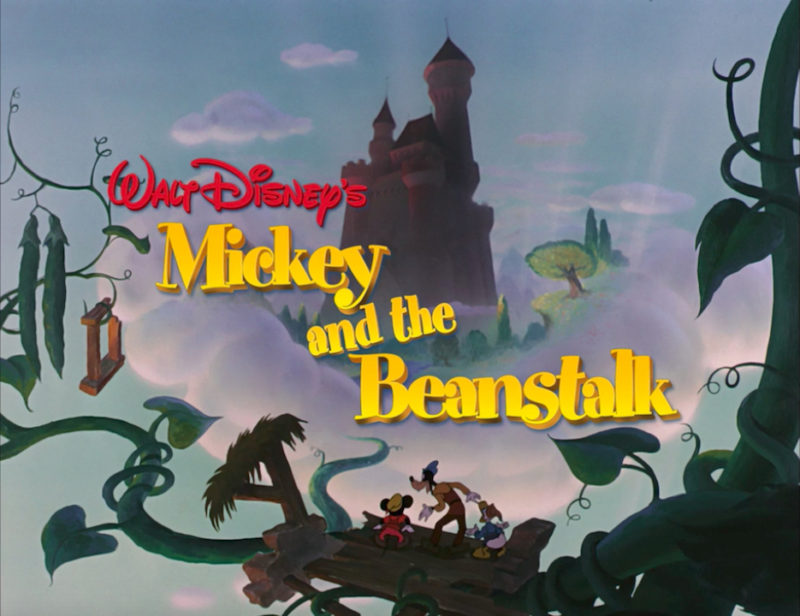
“Jack and the Beanstalk” is the American Psycho of fairy tales.
The hero breaks into a man’s house, steals his possessions, and murders him when caught in the deed. Most retellings add a clumsy exculpatory backstory (the giant killed Jack’s father, or something), but the tale has enough malevolence to be an interesting choice for one of the Disney studio’s “fairytale + mouse” adaptions.
Mickey and the Beanstalk was released with center billing in 1947’s Fun and Fancy Free, and re-cut for TV several times with different narrators, including Ludwig Von Drake, Shari Lewis, and Winnie the Pooh voice actor Sterling Holloway. The tale begins in Happy Valley, where “all the world is gay”. The gayness stems from a magical harp, which is stolen one fateful night. The crops fail and the river dries up, leaving three unfortunate peasants (Mickey Mouse, Donald Duck, and Goofy) facing starvation. There’s a hilarious gag involving Mickey Mouse slicing transparently thin sandwiches from a single slice of bread.
Mickey foolishly trades their last cow for some magic beans, which grow into a huge beanstalk, reaching up into the clouds and a giant’s castle. The giant is one hell of a dude: you’d think merely being a giant would be enough, but he also possesses magical powers allowing him to fly or transform into anything. It’s like the Tommy Lee/Pam Anderson sex tape, where we discover that, in addition to being a millionaire rockstar, Tommy Lee also has a huge penis. Some guys get all the luck.
Mickey’s plan to trick the giant into turning into a fly and swatting him fails, and Donald and Goofy are locked inside a snuff box. This leads to the film’s most nail-biting moment – Mickey stealing the key from the giant’s pocket while he sleeps. It’s unfortunately necessary to kill the giant at this point, which they achieve through a method that doesn’t make a lot of sense given what we know about his powers.
Mickey and the Beanstalk is well animated, well conceived, and has some laughs. If I had a complaint, it doesn’t find a use for Goofy. Disney’s “big three” are types: Mickey is the straight man, Donald is angry, spiteful, and insecure, and Goofy is the good-natured fool. The latter role is filled by the giant, giving Goofy nothing to do (except a cute scene where he tries to rescue his hat from a giant-sized block of jelly).
There is (perhaps) a deeper level to this film than I initially thought.
In 1913, an aqueduct was built, diverting the Owens River to Los Angeles. This enabled La-La Land to grow to its current size, but it had a dark side: Owens Lake completely dried up, devastating Owens Valley and ruining the livelihood of many farmers. The man responsible for this was William Mulholland. It might be a coincidence, but the name of the giant is “Big Willie”. I also note that Owens Lake is only a three hour drive from Burbank.

The last bastion for socially unacceptable behavior is when the perpetuator is an animal. They attack us, and destroy our property, and it’s hilarious. If they were capable of speech, perhaps we’d even allow them to make racist jokes and misgender trans people.
It’s not that they lack the intelligence to understand their actions, it’s that their systems of values are fundamentally unrelatable to ours. A human looks upon a carefully laid table and sees effort and organisation; a housecat sees fun shiny objects to bat and knock around. You get the sense that even if you could explain to a housecat what it’s doing, it wouldn’t care. Misbehaving animals are funny, but also disquietening: as though we’re getting a taste of what an alien invasion might be like.
Untitled Goose Game is an indie puzzle/adventure game where you play as a goose, wandering around one of those insufferably whimsical British towns that have names like Toddlefold or Nippleshire. You have a checklist of tasks to complete, which basically reduce to “annoy as many people as possible.”
You steal laundry, destroy gardens, ruin picnics, and honk at people, The game bears some resemblance to Pulse Entertainment’s notorious 1996 adventure game Bad Mojo, where you are a cockroach, and your objectives are to basically…be a cockroach. Here, as there, you are invited to reject your own species, and view them as the Other. Most humans (with the exception of two women who find the goose hilarious) are enemies, to be avoided or navigated around.
It will take you a couple of hours to beat. When the game is on the verge of overstaying its welcome, it ends.
The graphics are cell shaded or flat shaded (or whatever the fuck the trendy term for it is now), . Environments are clean, while retaining enough detail to have verisimilitude. The human models walk with a jerky, odd gait, but I believe this is intentional: from a goose’s perspective, humans are ridiculous. The music is dynamic, changing to reflect the in-game action, and the sound design is nicely detailed (the acoustics of the goose’s honks change when its beak is inside a glass bottle, for instance).
I grew weary of debates about games vs art a long time ago. Most of the games praised as “artistic” are in fact regurgitations of cinematic tropes. They only seem profound because you’re comparing them with Candy Crush. In a 2010 Cracked column, Robert Brockway praised the “artistry” of a scene in Call of Duty: Modern Warfare where you crawl around and die of radiation burns. Is this the groundbreaking artistry of videogaming? Cultural commentary about how war is hell?
Untitled Goose Game is a clearer statement of videogaming as an art form. It has no story, no “point”, and ludonarrative interaction drives the game. Even title seems more suggestive of a painting (where it’s common for work) than something from Hollywood.
Untitled Goose Game is now in the inevitable backlash stage of its hype cycle, but it’s perfectly good at being what it is, even if it’s something that’s confusing and meaningless to a lot of people. It has an unusual premise, and it’s even a little philosophical. When William Wallace was arrested and charged with treason, he retorted. “I could not be a traitor to Edward, for I was never his subject.” Animals are not our subjects. They exist outside our world.

This is the supposed eighteenth chapter to Joan Lindsay’s Picnic At Hanging Rock, solving the mystery of what happened to the missing women.
I say “supposed” because the internet is rife with conspiracy theories that Joan Lindsay didn’t write it, that it’s a hoax, et cetera.
I’m not convinced. The number of parties necessary to orchestrate such a fraud (Lindsay’s estate, editor, publisher, surviving relatives, and so on) would be large, and the prose reads like Lindsay’s (for example, the usage of “little” in its diminutive/feminine sense.) Its contents also comport with what we know of Lindsay’s literary interests. Until I see evidence otherwise, I take Secret at face value: the unpublished work of Joan Lindsay.
It’s understandable that people would want to decanonize The Secret of Hanging Rock. Everyone who reads it reacts with disappointment. I don’t know of a single person who thinks it improves the book. It’s a few pages long, and much of its text was retrofitted into chapter 3 of Hanging Rock. In short, the girls disappeared into a rift in time. There are some gestures towards quantum cosmology, as well as Aboriginal “dreamtime” and therianism. That’s it.
It’s a bad, unsatisfying ending, one level above “a wizard did it”. Hanging Rock is a “who killed Laura Palmer?” type of story – the mystery’s the entire point, and explaining the mystery kills the story stone dead. You’re not supposed to know where the girls went. Hanging Rock was like a crossword puzzle in a newspaper: fun until you solve it, then it becomes a fish-wrapper.
Secret is so threadbare and underwhelming that I started pondering other things: such as the ethics of publishing a dead writer’s unfinished work. Nirvana fans are familiar with this game: every few years someone finds a shoebox of tapes and we’re subjected to yet another posthumous Kurt Cobain “album” containing abandoned scraps of music that he definitely wouldn’t have wanted the public to hear.
Is it right to do this? Release all of a famous artist’s outtakes once they’re too dead to complain?
I can see the opposite argument; authors don’t have unlimited fiat to declare that nobody read their work, particularly when it relates to something of public or literary importance (like Picnic at Hanging Rock). Consider Anne Frank’s diary. If someone wrote the cure for cancer on a piece of paper and commanded the world to never read it, we probably shouldn’t honor that request, either.
At the end, Hanging Rock was about time, and how time blurs reality. Reading the book is a maddening experience: you know that whatever happened to the girls, it’s knowledge out of your reach. Knowing what happens yanks the story back down to earth, and destroys its appeal. Hanging Rock left you like Aesop’s fox, snapping at grapes that are just out of reach. Secret cuts down the tree and lets you gorge on grapes until you’re become violently sick. Enjoy your stomach-ache.



